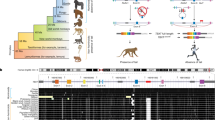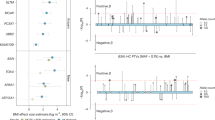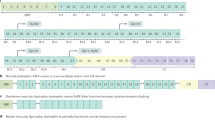Abstract
ACHONDROPLASIA, the most common cause of chondrodysplasia in man (1 in 15,000 live births), is a condition of unknown origin characterized by short-limbed dwarfism and macrocephaly1,2. More than 90% of cases are sporadic and there is an increased paternal age at the time of conception of affected individuals, suggesting that de novo mutations are of paternal origin. Affected individuals are fertile and achondroplasia is transmitted as a fully penetrant autosomal dominant trait, accounting for rare familial forms of the disease (l0%))3–6. In contrast, homozygous achondroplasia is usually lethal in the neonatal period and affects 25% of the offspring of matings between heterozygous achondroplasia parents. The gene responsible for achondroplasia has been mapped to chromosome 4pl6.3 (refs 7, 8); the genetic interval encompassing the disease gene contains a member of the fibroblast-growth-factor receptor (FGFR3) family which is expressed in articular chondrocytes. Here we report the finding of recurrent missense mutations in a CpG doublet of the transmembrane domain of the FGFR3 protein (glycine substituted with arginine at residue 380, G380R) in 17 sporadic cases and 6 unrelated familial forms of achondroplasia. We show that the mutant genotype segregates with the disease in these families. Thus it appears that recurrent mutations of a single amino acid in the transmembrane domain of the FGFR3 protein account for all cases (23/23) of achondroplasia in our series.
This is a preview of subscription content, access via your institution
Access options
Subscribe to this journal
Receive 51 print issues and online access
$199.00 per year
only $3.90 per issue
Buy this article
- Purchase on Springer Link
- Instant access to full article PDF
Prices may be subject to local taxes which are calculated during checkout
Similar content being viewed by others
References
Maroteaux, P. & Lamy, M. Clin. Orthop. 33, 91–103 (1964).
Oberklaid, F., Danks, D. M., Jensen, F., Stace, I. & Rosshandler, S. J. med. Genet. 16, 140–146 (1979).
Murdoch, J. L. et al. Ann. hum. Genet. 33, 227–244 (1970).
Orioli, I. M., Castilla, E. E. & Barbosa-Neto, J. G. J. med. Genet. 23, 328–332 (1986).
Stoll, C., Dott, B., Roth, M. P. & Alembik, Y. Clin. Genet. 35, 88–92 (1989).
Gardner, R. J. M. Clin. Genet. 11, 31–38 (1977).
Le Merrer, M. et al. Nature Genet. 6, 318–321 (1994).
Velinov, M. et al. Nature Genet. 6, 314–317 (1994).
Stanescu, R., Stanescu, V. & Maroteaux, P. Am. J. med. Genet. 37, 412–421 (1990).
Thompson, L. et al. Genomics 11, 1133–1142 (1991).
Ullrich, A. & Schlessinger, J. Cell 61, 203–212 (1990).
Keegan, K., Johnson, D., Williams, L. T. & Hayman, M. J. Proc. natn. Acad. Sci. U.S.A. 88, 1095–1099 (1991).
Kato, Y. & Iwamoto, M. J. biol. Chem. 265, 5903–5909 (1990).
Iwamoto, M., Shimazu, A., Nakashima, K., Suzuki, F. & Kato, Y. J. biol. Chem. 266, 461–467 (1991).
Ornitz, D. M. & Leder, P. J. biol. Chem. 267, 16305–16311 (1992).
Pasquale, E. B. Proc. natn. Acad. Sci. U.S.A. 87, 5812–5816 (1990).
Williams, L. T. Science 243, 1564–1570 (1989).
Edery, P. et al. Nature 367, 378–380 (1994).
Author information
Authors and Affiliations
Rights and permissions
About this article
Cite this article
Rousseau, F., Bonaventure, J., Legeai-Mallet, L. et al. Mutations in the gene encoding fibroblast growth factor receptor-3 in achondroplasia. Nature 371, 252–254 (1994). https://doi.org/10.1038/371252a0
Received:
Accepted:
Issue Date:
DOI: https://doi.org/10.1038/371252a0
This article is cited by
-
Review of published 467 achondroplasia patients: clinical and mutational spectrum
Orphanet Journal of Rare Diseases (2024)
-
Surgical outcome after treatment of thoracolumbar spinal stenosis in adults with achondroplasia
European Spine Journal (2024)
-
Vosoritide Therapy in Children with Achondroplasia: Early Experience and Practical Considerations for Clinical Practice
Advances in Therapy (2024)
-
Activated FGFR3 suppresses bone regeneration and bone mineralization in an ovariectomized mouse model
BMC Musculoskeletal Disorders (2023)
-
Craniofacial growth and function in achondroplasia: a multimodal 3D study on 15 patients
Orphanet Journal of Rare Diseases (2023)
Comments
By submitting a comment you agree to abide by our Terms and Community Guidelines. If you find something abusive or that does not comply with our terms or guidelines please flag it as inappropriate.



